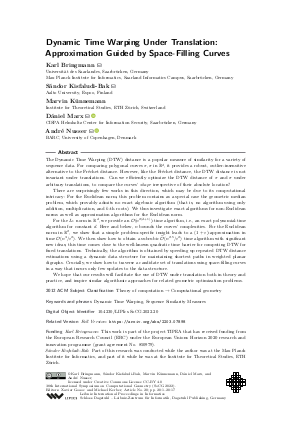@InProceedings{bringmann_et_al:LIPIcs.SoCG.2022.20,
author = {Bringmann, Karl and Kisfaludi‑Bak, S\'{a}ndor and K\"{u}nnemann, Marvin and Marx, D\'{a}niel and Nusser, Andr\'{e}},
title = {{Dynamic Time Warping Under Translation: Approximation Guided by Space-Filling Curves}},
booktitle = {38th International Symposium on Computational Geometry (SoCG 2022)},
pages = {20:1--20:17},
series = {Leibniz International Proceedings in Informatics (LIPIcs)},
ISBN = {978-3-95977-227-3},
ISSN = {1868-8969},
year = {2022},
volume = {224},
editor = {Goaoc, Xavier and Kerber, Michael},
publisher = {Schloss Dagstuhl -- Leibniz-Zentrum f{\"u}r Informatik},
address = {Dagstuhl, Germany},
URL = {https://drops.dagstuhl.de/entities/document/10.4230/LIPIcs.SoCG.2022.20},
URN = {urn:nbn:de:0030-drops-160287},
doi = {10.4230/LIPIcs.SoCG.2022.20},
annote = {Keywords: Dynamic Time Warping, Sequence Similarity Measures}
}

 Creative Commons Attribution 4.0 International license
Creative Commons Attribution 4.0 International license












